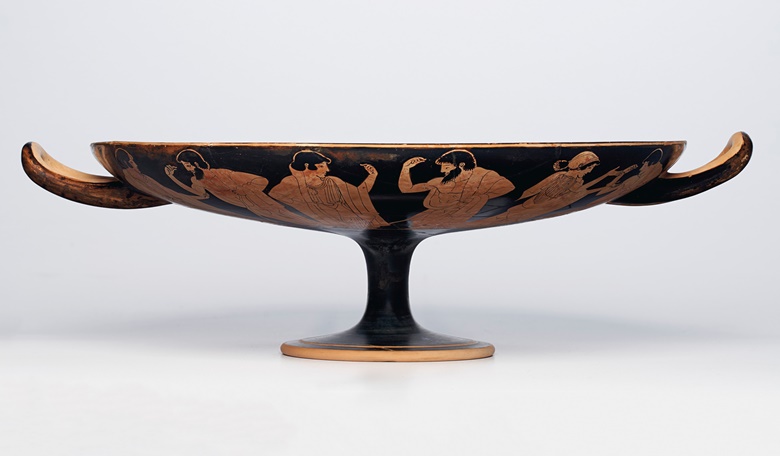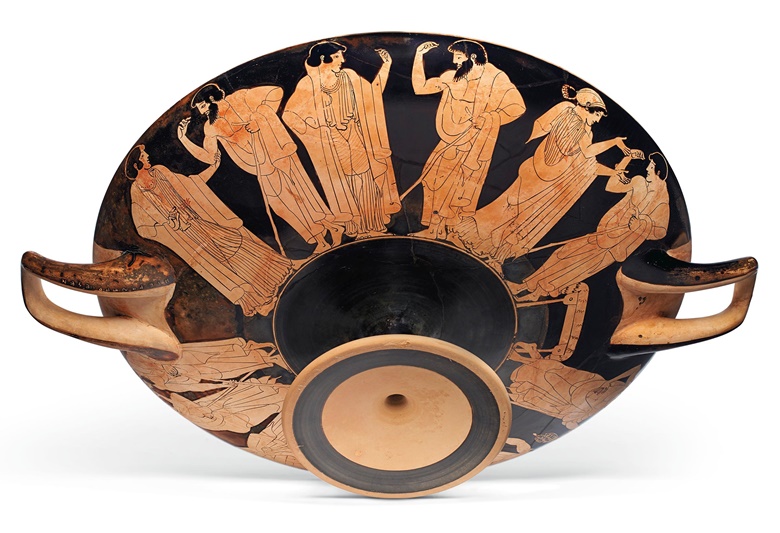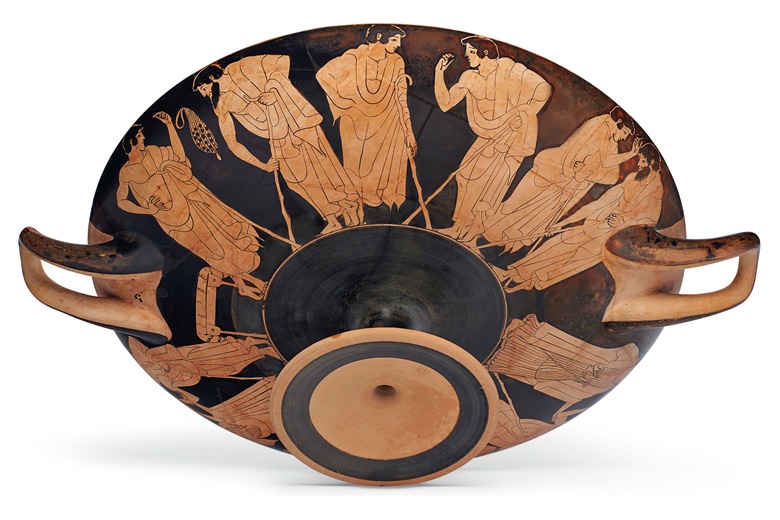Will this wine cup set a new auction record for a Greek vase?
This Attic red-figured kylix — attributed to the painter Makron and of ‘outstanding provenance’ — could be about to eclipse a landmark figure set 20 years ago, says Harry Seymour
The year 490 BC was a memorable one for the people of Athens: 10,000 of the city’s soldiers crushed the much larger Persian army of Darius the Great; work commenced on the first Temple of Athena Parthenos on the Acropolis; and the modern marathon was born when a messenger with good news supposedly ran 26 miles to the city before dropping dead.
It is also thought to be the year in which an artist known as Makron began his decade-long career painting ceramics in the Kerameikos — the potters’ quarter — in Athens.
‘He soon established himself as one of the best painters of his generation,’ says G. Max Bernheimer, international head of Antiquities at Christie’s. ‘And this Attic red-figured wine cup — offered on 13 October at Christie’s in New York — is the best example by the fabled artist to come to auction in decades.’
The birth of Makron’s ‘red-figure’ style
Makron worked in a relatively new style known as ‘red-figure’, which involved creating shapes from negative space against a painted background. Details were then added with a brush and slip. This technique replaced the predominant ‘black-figure’ style, which required detail to be incised into painted figures, and made portraying pictorial depth tricky.
Makron’s name survives today thanks to a single signed work, a skyphos now in the Museum of Fine Arts in Boston, which features the words ‘Makron drew me’ painted on one handle.
The underside of one of the cup’s handles was inscribed by the potter with the words, ‘Hieron made me’
In the 20th century, however, a further 350 ceramics (including this one) were attributed to Makron by the Oxford University professor Sir John Beazley (1885-1970). Beazley catalogued thousands of Greek vases by studying each painter’s style in minute detail. In the case of Makron, his characters feature distinctive round heads with flat tops and drapery folds drawn with great finesse.
Today, nearly all of Makron’s vases are housed in major institutions, including the Met, the Louvre, the British Museum and the Getty. According to Bernheimer, ‘Hardly any are left in private hands, which makes this one all the more desirable to collectors.’
Makron, Hieron and the kylix
Makron had a favourite potter, Hieron, with whom he worked almost exclusively in the Kerameikos. Hieron was perhaps less opposed than Makron to signing his work. ‘Roughly 30 cups attributed to Makron carry Hieron’s autograph,’ explains Bernheimer. ‘Usually it’s painted on, but on this example he incised the words ‘‘Hieron made me’’ into the clay under one of the cup’s handles.’
Hieron mostly made wine cups, in particular a type of wide-brimmed, shallow-footed cup known as a kylix, which was used for serving watered-down wine at raucous male-only symposia.
As the wine was sipped from the kylix over the course of an evening, the cup’s central motif would reveal itself. Some would show ships that appeared to float in the crests of the drink, while others depicted scenes of revellers vomiting from intoxication.
An Attic red-figured kylix, attributed to Makron as painter, signed by Hieron as potter, c. 490-480 BC. 13⅜ in (34 cm) diameter. Estimate: $1,200,000-1,800,000. Offered in Antiquities on 13 October 2020 at Christie’s in New York
Inside the tondo of this cup, Makron painted a rare mythological scene. On the left, wearing a short chiton and belted cuirass, a young warrior rests on his spear next to an elegantly plumed Thracian helmet. Next to him, wearing an ankle-length chiton and holding a T-shaped staff, sits his father.
The characters can be identified from two labels, originally painted in red but now barely visible. The young man is Antilochus, the prince of Pylos in Homer’s Odyssey. His father is King Nestor, but incorrectly labelled as Lykomedes. ‘Funnily enough, this isn’t the only example we know of in which Makron gets his names muddled,’ Bernheimer explains. ‘Another kylix in the State Hermitage Museum in St. Petersburg shows Theseus attacking Medea, who is wrongly named as his own mother, Aithra.’
According to Greek mythology, Antilochus was a friend of the swift-footed warrior Achilles. The lost epic Aethiopis described how he sacrificed his own life to save his father’s, fulfilling a tragic oracle. ‘Neither of the characters’ eyes meet — the painting’s tension is palpable,’ says Bernheimer.
The rules of the game
As the night progressed and the wine diminished, the lees at the bottom of the cup would be used to play kottabos, a popular drinking game.
The rules were simple. While placing the right index finger through a handle and swirling the dregs, each player took it in turns to dedicate a toast. Then, while leaning back on a couch, they flung the sediment at a central target — perhaps a bronze disc balanced on a tripod or a saucer floating in a bowl.
The drinker with the best aim won a prize — often a kiss from the recipient of their toast.
Three draped men (two with beards, one more youthful), each with a wreath in their hair and holding a staff, cavorting with a hetaira (or courtesan)
The cup’s exterior decoration reflects this theme of courtship. One side shows three men, each casually leaning on a staff and talking to a hetaira, a well-educated female courtesan.
The opposite side shows three pairs of males courting one another. In Athenian culture, says Bernheimer, it was commonplace for older men to have a young male partner (as well as a wife), whom they would educate, protect and love.
Three pairs of men, each wearing a himation and leaning on a staff, engaged in courtship
A final but crucial aspect of this cup’s value, the specialist says, lies in its provenance.
‘It was first published in 1963 in Beazley’s seminal work Attic Red Figure Vase-Painters,’ explains Bernheimer. ‘That means it easily clears the UNESCO convention that prohibits the transfer of cultural property discovered after 1970. For institutions and collectors alike, that’s a big plus.’






No comments:
Post a Comment